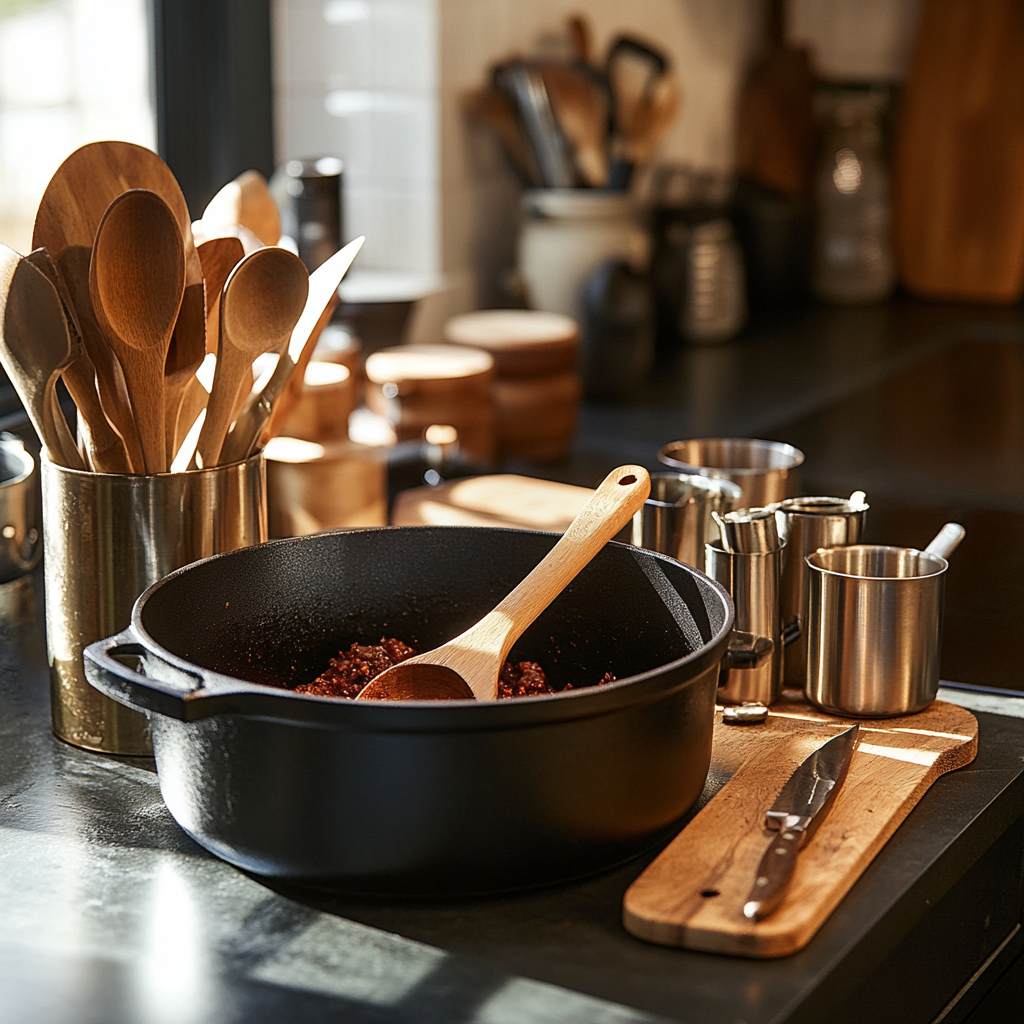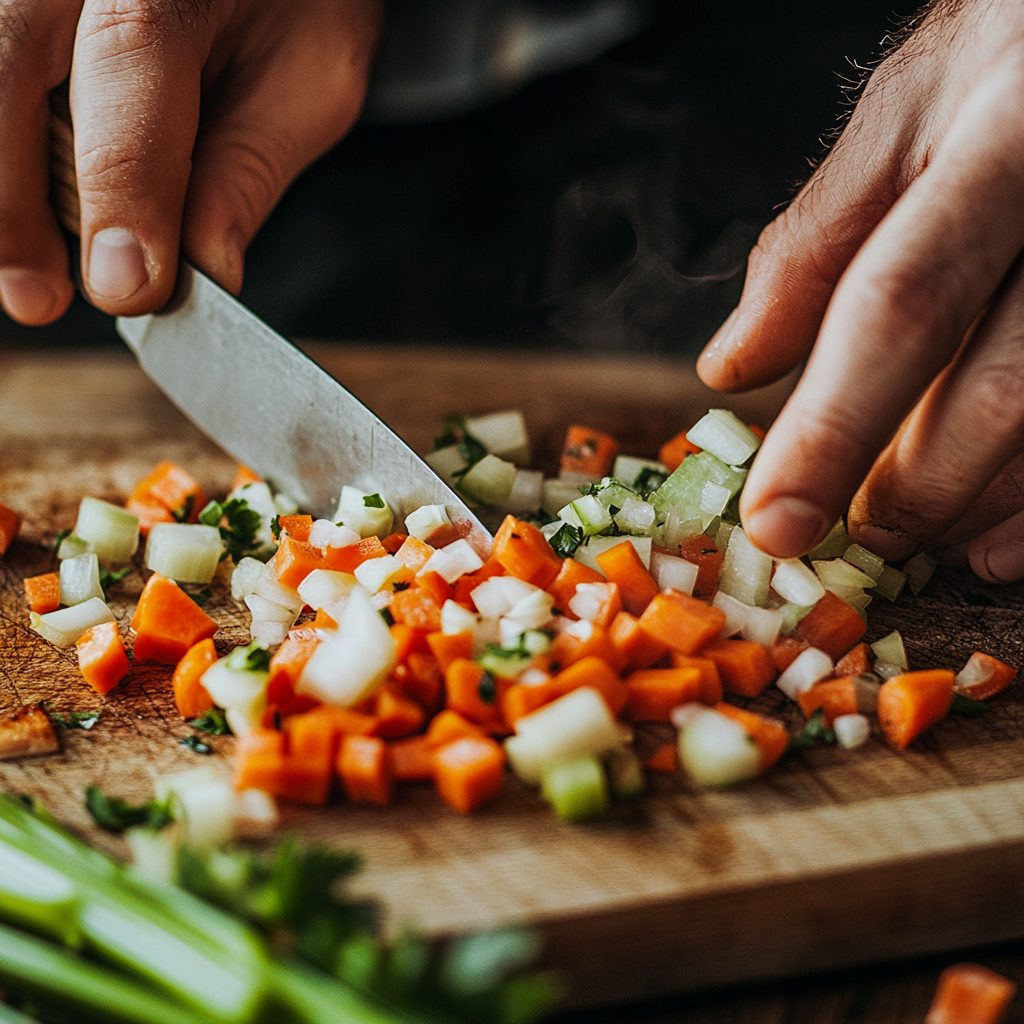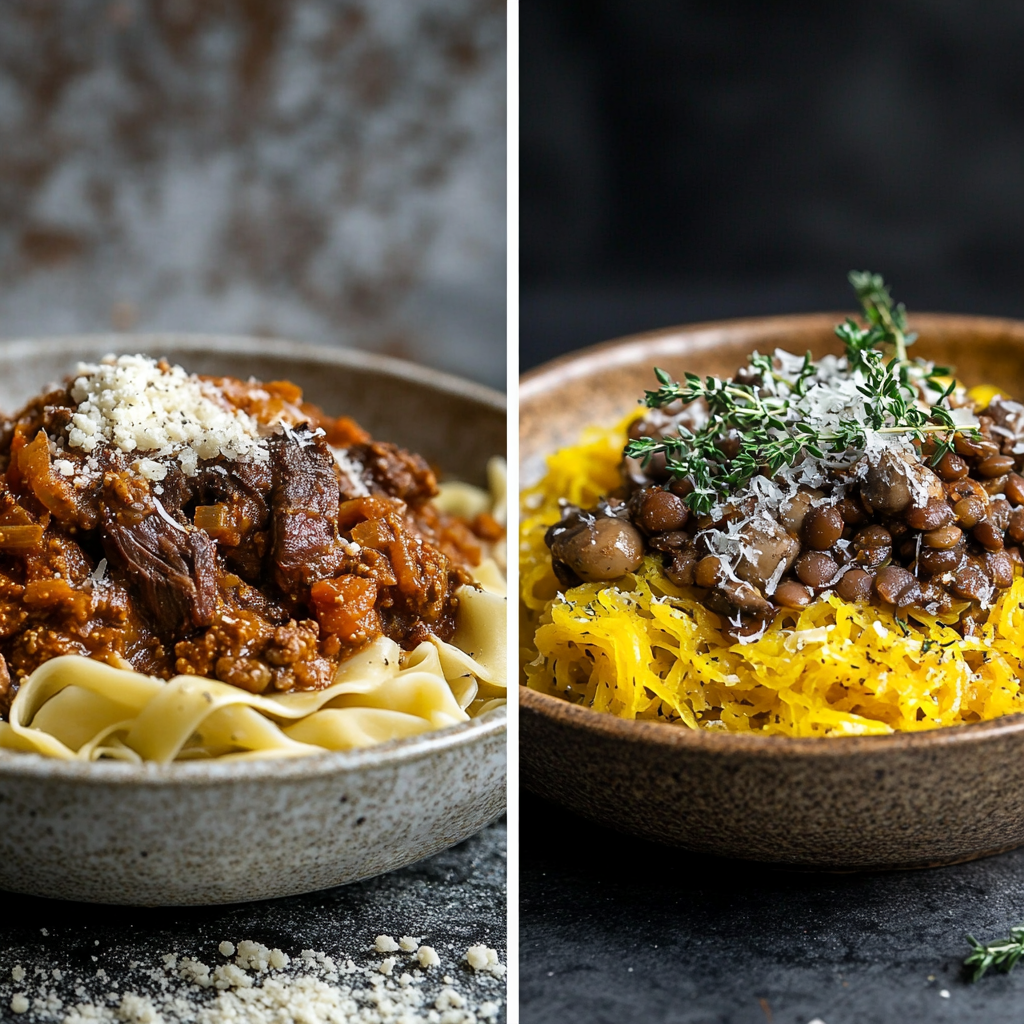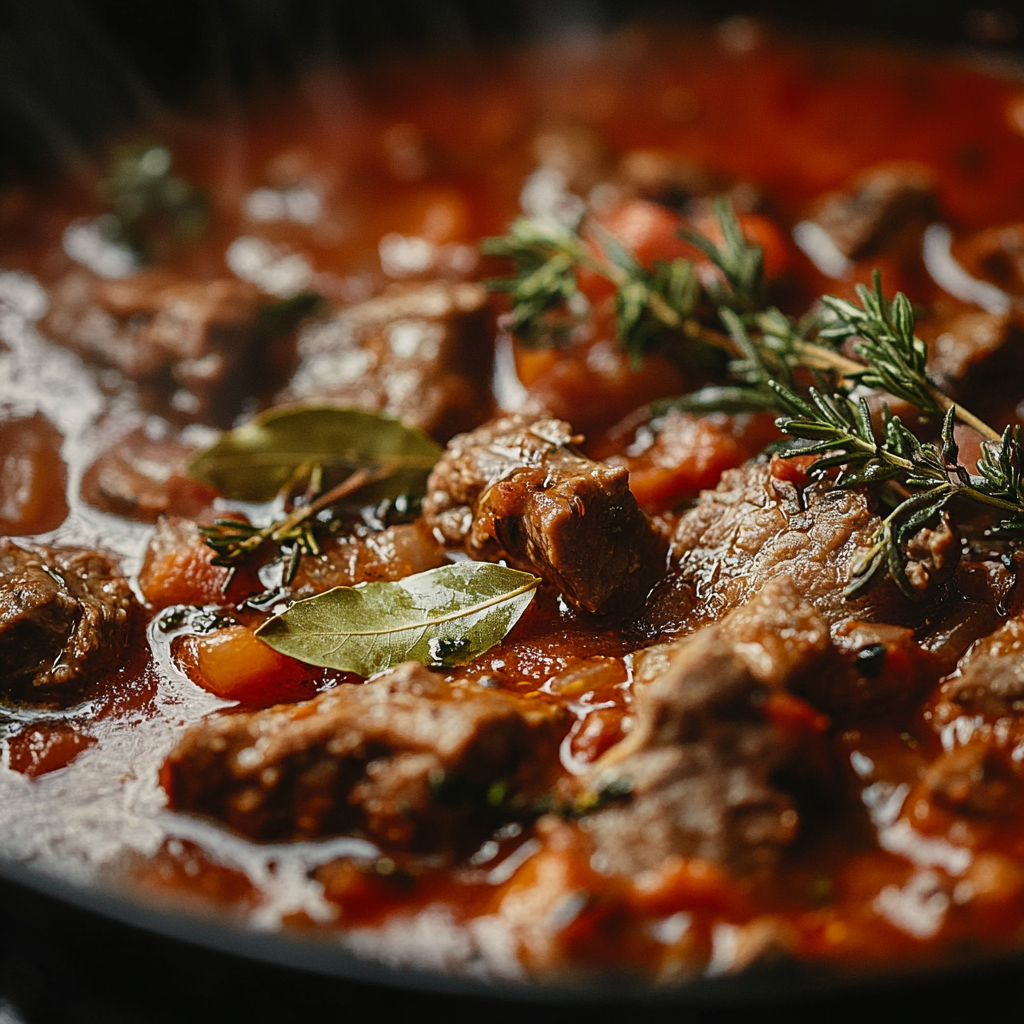Bison in Wild Boar Ragu Recipe: A Rich and Hearty Delight
For those seeking a truly rich, hearty, and unique meal, look no further than this bison in wild boar ragu recipe. Combining two of the most flavorful meats available – bison and wild boar – this dish offers a deeply satisfying dining experience, blending the natural bold flavors of wild game with a rich tomato-based sauce. Whether you’re preparing this dish for a special occasion or just want to elevate your weeknight dinner game, this recipe provides an unforgettable culinary experience.
Both bison and wild boar are lean and packed with nutrients, making them excellent choices for those seeking a healthier yet indulgent meal. What makes this ragu stand out is the combination of intense flavors, complemented by a slow-simmered sauce that allows the meats to tenderize and absorb the rich flavors of tomatoes, garlic, and herbs. Using high heat at the beginning ensures that the meats are perfectly seared, locking in all their juices, while the low simmering that follows melds the flavors into a delightful harmony.
Not only is this dish suitable for various dietary needs, such as low-carb, paleo, and gluten-free diets, but it can also be adapted to personal preferences. The cooking process itself takes around 15 minutes, making it an excellent option when you’re short on time but still want something impressive.
For more inspiration on how to elevate your meals with hearty, savory recipes, make sure to explore our Dinner section, where you’ll find plenty of mouthwatering dishes to try.
Ingredients Overview: A Breakdown of the Components for Bison in Wild Boar Ragu
Creating a flavorful ragu starts with choosing the right ingredients. This bison in wild boar ragu recipe calls for high-quality meats and fresh ingredients that come together to form a savory, deeply satisfying sauce. Let’s dive into the key ingredients and possible substitutions to suit various dietary needs.
Main Ingredients:
- Ground bison (1 pound): Bison is a lean, flavorful meat that pairs beautifully with wild boar. Rich in protein and lower in fat than beef, bison is a healthy option that brings depth to this dish without being too heavy.
- Ground wild boar (1 pound): The star of this ragu, wild boar has a unique, slightly gamey flavor. This makes it more complex than pork but still accessible to those who enjoy rich, savory dishes. Wild boar also contains less fat than domestic pork, contributing to the overall leanness of the ragu.
- Olive oil (2 tablespoons): For sautéing the meats and vegetables. Olive oil provides a smooth richness to the sauce, complementing the flavors of the meats and vegetables.
- Onion (1 large, finely chopped): Onions add a hint of sweetness to the sauce, balancing the rich, savory flavors of the meats.
- Carrots (2 medium, finely diced): Carrots lend a natural sweetness and depth to the ragu. Their slight sweetness balances the acidity of the tomatoes.
- Celery stalks (2, finely diced): A classic ingredient in many ragus, celery adds an earthy note to the dish, which complements the gamey flavors of the wild boar.
- Garlic (4 cloves, minced): The garlic provides an aromatic, sharp contrast that elevates the flavors of the meats and tomatoes.
- Crushed tomatoes (1 can, 28 ounces): The tomatoes form the base of the sauce, adding acidity, richness, and a bright red color. Choose high-quality crushed tomatoes for the best flavor.
- Red wine (½ cup): A splash of red wine enhances the depth and complexity of the sauce, bringing out the natural flavors of the bison and wild boar.
- Bay leaf (1 leaf): The bay leaf adds a subtle layer of herbal flavor, infusing the sauce as it simmers.
- Fresh thyme (1 teaspoon): Fresh thyme complements the savory and gamey notes of the wild boar and bison, adding aromatic complexity to the ragu.
- Salt and pepper (to taste): Season the dish as it cooks, adjusting based on personal preference.
- Parmesan cheese (for garnish): Optional but highly recommended, as Parmesan adds a nutty, salty finish to the ragu.
Ingredient Substitutions:
- Gluten-Free Option: This recipe is naturally gluten-free. However, if you plan to serve it over pasta, opt for gluten-free options like chickpea or rice pasta to keep the meal gluten-free.
- Vegan Option: For a plant-based version, substitute the bison and wild boar with lentils or a combination of mushrooms and textured vegetable protein. These options provide the hearty texture and rich flavor needed for a satisfying vegan ragu.
- Dairy-Free: Simply omit the Parmesan cheese or use a plant-based Parmesan substitute to keep the recipe dairy-free.
Need more ideas for dishes that cater to specific dietary needs? Explore our Snacks section for a variety of adaptable meal ideas.

Tools Needed: Essential Equipment for Preparing Wild Boar Ragu
The best part about this bison in wild boar ragu recipe is that you don’t need any special equipment to prepare it. With just a few basic kitchen tools, you’ll have everything you need to create this savory, rich dish. Here’s a list of the essential tools you’ll need to get started.
Essential Kitchen Tools:
- Large heavy-bottomed skillet or Dutch oven: This is the most important tool for this recipe. A heavy-bottomed skillet or Dutch oven will help you brown the meat evenly over high heat, then slowly simmer the sauce to perfection.
- Wooden spoon: A wooden spoon is ideal for stirring the meat and sauce as it cooks. It’s gentle on the pan but sturdy enough to break up the meat and ensure even cooking.
- Sharp knife: You’ll need a sharp knife for finely chopping the vegetables (onions, garlic, carrots, and celery) that form the base of the ragu.
- Measuring cups: These are essential for measuring out the liquids, such as the red wine and olive oil, to ensure accuracy.
- Ladle: A ladle makes it easy to serve the ragu once it’s finished cooking, whether you’re serving it over pasta or polenta.
Tool Substitutions:
- No Dutch oven? If you don’t have a Dutch oven, a large cast-iron skillet or stainless-steel pan will work just as well. Make sure the pan is large enough to accommodate both the meat and sauce.
- No measuring cups? In a pinch, you can use a wine glass to approximate the half-cup of red wine required for the recipe.
For more recipes that require simple kitchen tools, visit our Dinner section for a variety of dishes that can be made with minimal equipment.

Step-by-Step Instructions: How to Make Bison in Wild Boar Ragu
This bison in wild boar ragu recipe may sound fancy, but it’s actually quite straightforward to prepare. Follow these step-by-step instructions, and you’ll have a hearty, flavorful meal in no time. Even beginners in the kitchen will find this recipe easy to follow.
Step 1: Sear the Meats
Start by heating the olive oil in your heavy-bottomed skillet or Dutch oven over high heat. Once the oil is hot, add the ground bison and wild boar, breaking the meat up with a wooden spoon. You want to brown the meat thoroughly on all sides, which should take about 5-7 minutes. The goal here is to develop a deep, caramelized crust on the meat that will add incredible flavor to the final dish.
Once the meat is fully browned and most of the liquid has evaporated, transfer it to a plate and set aside. This step is crucial to avoid overcrowding the pan, which would result in steaming the meat instead of browning it.
Step 2: Cook the Vegetables
In the same skillet, lower the heat to medium and add the chopped onions, carrots, and celery. Sauté the vegetables for about 5 minutes, or until they begin to soften and release their natural sweetness. Stir occasionally to prevent burning.
After 5 minutes, add the minced garlic and cook for an additional minute, just until the garlic becomes fragrant. Be careful not to burn the garlic, as this can result in a bitter taste.
Step 3: Deglaze the Pan
Once the vegetables are softened and aromatic, it’s time to deglaze the pan. Pour in the red wine, using your wooden spoon to scrape up any browned bits from the bottom of the pan. These bits are packed with flavor and will enhance the overall depth of the ragu.
Let the red wine simmer for about 2-3 minutes, allowing the alcohol to evaporate while intensifying the flavor of the sauce.
Step 4: Add Tomatoes and Herbs
Next, add the can of crushed tomatoes, the bay leaf, and the fresh thyme to the skillet. Stir everything together until the ingredients are well combined. Season the mixture with salt and pepper to taste.
Step 5: Simmer the Ragu
Return the browned bison and wild boar to the skillet, stirring them into the tomato mixture. Lower the heat and cover the pan, allowing the ragu to simmer gently for about 15 minutes. Stir occasionally to prevent the sauce from sticking to the bottom of the pan.
As the ragu simmers, the flavors will meld together, and the sauce will thicken. You’ll end up with a rich, meaty sauce that’s perfect for serving over pasta, polenta, or roasted vegetables.
Step 6: Serve
Once the ragu is ready, remove the bay leaf and discard it. Ladle the rich, savory ragu over your chosen base, whether it’s pasta, polenta, or even roasted vegetables. Garnish with freshly grated Parmesan cheese for an extra layer of indulgence.
For more recipes that use similar cooking methods, visit our Breakfast section, where you’ll find plenty of inspiration for meals that are easy to prepare but packed with flavor.

Flavor Variations: How to Customize Your Bison in Wild Boar Ragu
This bison in wild boar ragu recipe is incredibly versatile and can be customized to suit your tastes or dietary preferences. Whether you want to add extra flavors or adjust the recipe for dietary restrictions, here are some ideas for making the dish your own.
Flavor Additions:
- Mushrooms: Adding sautéed mushrooms to the sauce can enhance the earthiness of the dish. Try using cremini or shiitake mushrooms for their rich, umami flavor.
- Spicy Ragu: For a little heat, add a pinch of red pepper flakes or a dash of cayenne pepper to the tomato sauce. This will give the ragu a spicy kick without overwhelming the other flavors.
- Herb Variations: While thyme and bay leaf are classic choices for ragu, you can experiment with other herbs like rosemary, sage, or oregano. Each herb will bring a different aromatic quality to the dish.
Dietary Adaptations:
- Low-Carb Option: If you’re following a low-carb diet, serve the ragu over zucchini noodles or roasted spaghetti squash instead of traditional pasta. This keeps the dish light while still offering a hearty, comforting meal.
- Vegan Option: For a plant-based variation, replace the bison and wild boar with lentils and sautéed mushrooms. The lentils will add protein and a satisfying texture, while the mushrooms bring earthy, umami notes to the dish.
Looking for more creative ways to adapt your favorite meals? Visit our Snacks section for more tips on customizing recipes to suit your taste or dietary needs.

Expert Tips: How to Perfect Your Bison in Wild Boar Ragu
When working with lean, flavorful meats like bison and wild boar, it’s important to follow a few key tips to ensure your ragu turns out perfectly. Here are some expert tips to help you make the best bison in wild boar ragu every time.
Tip 1: Sear the Meat for Flavor
One of the most important steps in this recipe is searing the bison and wild boar over high heat. This step caramelizes the natural sugars in the meat, creating a rich, browned crust that adds incredible depth of flavor to the ragu. Be sure not to overcrowd the pan, as this will cause the meat to steam rather than brown.
Tip 2: Use Fresh Herbs
Fresh herbs like thyme and bay leaves bring a vibrant, aromatic quality to the sauce. If you can, use fresh herbs instead of dried, as they’ll infuse the ragu with more flavor. If you only have dried herbs on hand, use them sparingly, as their flavor is more concentrated.
For more tips on perfecting your favorite dishes, visit our Dinner section for expert advice on cooking with unique meats and ingredients.

Nutritional Information: Health Benefits of Bison and Wild Boar Ragu
This bison in wild boar ragu recipe isn’t just packed with flavor—it’s also loaded with nutrients. Both bison and wild boar are lean sources of protein, making them excellent choices for a healthy, balanced diet. Here’s a quick breakdown of the nutritional benefits you’ll find in each serving of this ragu:
- Calories: ~350 per serving
- Protein: 30g
- Fat: 15g (mostly healthy fats from olive oil and lean meats)
- Carbohydrates: 10g
- Fiber: 3g (thanks to the vegetables)
- Vitamin A: 15% of your daily value (from the carrots)
- Iron: 20% of your daily value (from the bison and wild boar)
Bison is a great source of lean protein, containing less fat and calories than beef, while still offering essential vitamins like B12 and zinc. Wild boar, on the other hand, is rich in iron and healthy fats, making it an excellent alternative to pork. Both meats provide a savory, nutrient-dense foundation for this dish.
For more detailed nutritional insights and dietary resources, check out Healthline, a trusted source for health and nutrition information.
Serving Suggestions: How to Pair Bison in Wild Boar Ragu with Sides
This hearty bison in wild boar ragu is a versatile dish that can be served with various side dishes. Whether you prefer a classic pasta pairing or something a bit lighter, here are some serving suggestions that complement the rich, savory flavors of the ragu.
Classic Pairings:
- Pasta: Wide, flat noodles like pappardelle or tagliatelle are traditional accompaniments for ragu. The thick pasta helps capture the rich, meaty sauce in every bite.
- Polenta: Creamy polenta provides a soft, smooth base that contrasts beautifully with the texture of the ragu.
- Garlic Bread: Serve a crusty garlic bread on the side to soak up the leftover sauce. The garlicky, buttery bread adds a delicious crunch that pairs well with the savory ragu.
Lighter Options:
- Roasted Vegetables: For a low-carb option, serve the ragu over roasted root vegetables like parsnips, carrots, or butternut squash. The sweetness of the vegetables balances the richness of the sauce.
- Zucchini Noodles: Spiralized zucchini makes for a light, low-carb alternative to pasta, keeping the dish fresh and healthy without sacrificing flavor.
For more ideas on pairing sides with hearty dishes like this, visit our Dinner section for a wide range of delicious suggestions.
Storage Tips: How to Store and Reheat Bison in Wild Boar Ragu
If you have any leftovers from this bison in wild boar ragu, you’ll be happy to know that it stores and reheats beautifully. Here are some tips for storing and reheating the ragu, so you can enjoy it later.
Refrigeration:
Store the ragu in an airtight container in the refrigerator for up to 3 days. When reheating, warm it gently in a saucepan over medium heat until heated through. Be sure to stir occasionally to prevent the sauce from sticking to the bottom of the pan.
Freezing:
Ragu freezes well, making it a great option for meal prep. Allow the ragu to cool completely before transferring it to a freezer-safe container. Freeze for up to 3 months. To reheat, thaw the ragu in the refrigerator overnight, then warm it on the stove over low heat.
For more tips on storing and reheating meals, visit our Snacks section for advice on keeping your favorite dishes fresh.
FAQs: Common Questions About Bison in Wild Boar Ragu
Here are some frequently asked questions about this bison in wild boar ragu recipe to help you achieve the best results.
Can I Substitute the Meat?
Yes! If you can’t find wild boar, ground pork is a suitable substitute, offering a slightly less gamey flavor. For bison, you can use lean ground beef or even lamb, though the flavor profile will be different.
Can I Make This Dish Ahead of Time?
Definitely. In fact, ragu often tastes better the next day as the flavors have more time to meld together. Simply refrigerate the sauce overnight and reheat it before serving.
What’s the Best Way to Serve This Ragu?
While this ragu is traditionally served over pasta or polenta, it’s also fantastic over roasted vegetables or even mashed potatoes. For a lighter option, try zucchini noodles or cauliflower mash.
For more tips and answers to common cooking questions, check out our Breakfast section for helpful advice and meal inspiration.
Conclusion: Why You Should Try This Bison in Wild Boar Ragu Recipe
This bison in wild boar ragu recipe is a must-try for anyone who loves hearty, flavorful dishes with a unique twist. The combination of lean bison and gamey wild boar creates a rich, savory sauce that’s perfect for a cozy weeknight dinner or a special occasion. Plus, with its versatility and health benefits, this dish is not only delicious but also a great way to incorporate more nutrient-rich meats into your diet.
For more incredible dinner ideas, make sure to check out our Dinner section, where you’ll find plenty of savory and satisfying meals to enjoy. And if you’re looking for more inspiration on cooking with game meats, take a look at this wild game recipe from Bon Appétit, offering more ideas on how to work with unique and flavorful meats.
